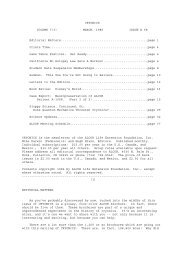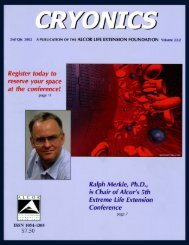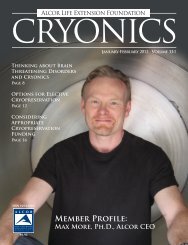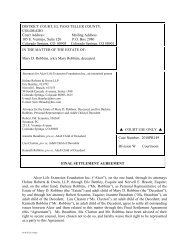Download PDF - Alcor Life Extension Foundation
Download PDF - Alcor Life Extension Foundation
Download PDF - Alcor Life Extension Foundation
Create successful ePaper yourself
Turn your PDF publications into a flip-book with our unique Google optimized e-Paper software.
The Singularity Is Near:<br />
When Humans Transcend Biology<br />
By Ray Kurzweil ~ London: Viking Penguin, 2005<br />
Book Review by R. Michael Perry, Ph.D.<br />
Ray Kurzweil is a well-known technologyoriented<br />
inventor and futuristic forecaster<br />
whose previous books include The Age of Intelligent<br />
Machines, The Age of Spiritual Machines:<br />
When Computers Exceed Human Intelligence, and<br />
(with Terry Grossman) Fantastic Voyage: Live<br />
Long Enough to Live Forever. The last title says<br />
much about his orientation to life, an outlook<br />
which also informs his latest book, The Singularity<br />
is Near.<br />
Kurzweil is an immortalist who hopes human<br />
life will be greatly extended and enhanced<br />
through means now being developed. In his<br />
latest book, he discusses his hope to “catch the<br />
wave” of this advancing technology to personally<br />
experience the new life it should enable. The<br />
“wave” itself will mushroom to a “Singularity”<br />
where computers are smarter than present-day<br />
humans and benefi ts abound. Among the benefi<br />
ts will be the liberation from biological limits<br />
on life span.<br />
By then, says Kurzweil, the world will be<br />
complex indeed, however, increases in human<br />
intelligence will have also occurred, enabling<br />
humans to continue to comprehend the world<br />
around them. People thus will not stay the<br />
same but become “enhanced humans,” keeping<br />
their humanity in the positive ways, yet acquiring<br />
greater talents along with becoming virtually<br />
indestructible. Since this will be available to<br />
people generally a personal wish for immortality<br />
can be linked to more general humanitarian<br />
concerns and need not at all<br />
be improperly “selfi sh,” as<br />
naysayers sometimes allege.<br />
But for those living today<br />
enough progress must<br />
occur in a time window of<br />
at most a few decades to<br />
prevent aging and diseases<br />
from taking their toll. The<br />
older and less healthy one is,<br />
the more urgent is the need<br />
for fast progress. (Kurzweil<br />
himself is in his late 50s and<br />
diabetic). It is Kurzweil’s<br />
premise that progress will likely be fast enough<br />
to save him and many others, and he bolsters his<br />
case with an extended analysis of technological<br />
growth.<br />
Technology is now dominated increasingly<br />
by information processing. According to Kurzweil,<br />
progress in various aspects of computer<br />
performance shows reassuring exponential<br />
growth rates in various measures of performance,<br />
one being amount of computation<br />
per unit cost of computing. Actually, in this<br />
case, the trend is faster than expected: computation<br />
speed doubled every three years in<br />
the early part of the 20th century, but now<br />
doubling happens every one year, so it appears<br />
that actually a faster, double-exponential<br />
rule is at work. Many other indicators<br />
of progress both in and outside the fi eld of<br />
computing show at least exponential growth,<br />
as charts lavishly illustrate, so there is some<br />
serious ground for optimism. It is interesting<br />
“It is Kurzweil’s premise that<br />
progress will likely be fast enough to<br />
save him and many others.”<br />
that natural evolution, the slower prologue of<br />
the human technological variety, also fi ts the<br />
exponential rule when interpreted in terms of<br />
various reasonable “paradigm shifts.” More<br />
generally progress gets “smarter” and accelerates<br />
even when not consciously directed.<br />
Kurzweil views time extending from remote<br />
prehistory into the future as comprising<br />
six epochs of progress, each an outgrowth<br />
of its predecessor: (1) physics and chemistry,<br />
(2) biology and DNA, (3) brains, (4) technology,<br />
(5) the merger of human technol-<br />
ogy with human intelligence, (6) “the<br />
universe wakes up.” The fi rst three of<br />
these predated the appearance of humankind<br />
and required many millions<br />
of years. Epoch four, human-driven<br />
technology, really started with protohumans<br />
several million years ago<br />
chipping stone tools, but quickened<br />
when near-modern humans emerged<br />
a few hundred thousand years ago.<br />
The acceleration in progress from<br />
then to now is particularly striking,<br />
considering that almost all this<br />
time was occupied by the Stone Age.<br />
Comparatively speaking, writing, mechanical<br />
printing, the industrial revolution, and automated<br />
computing have led up to the present<br />
technological blizzard with its promise of<br />
much more to come in a relative eyeblink.<br />
Epochs fi ve and six are yet to occur. But epoch<br />
fi ve at least, and our deliverance from ag-<br />
4 Cryonics/Spring 2006<br />
ing-induced mortality and other biological limitations,<br />
should only take a few more decades.<br />
The problems that must be solved for this<br />
all-important, penultimate step are formidable,<br />
however, and the “few more decades” could still<br />
be too many to save most of us now living. So<br />
it is not surprising that Kurzweil’s enthusiastic<br />
forecasting has inspired a backlash of controversy;<br />
some fi fty pages of his ample work are<br />
devoted to answering critics. In particular scientists<br />
often discount the idea of fast progress<br />
because they do not perceive the exponential or<br />
superexponential character of many of our advances,<br />
which are interconnected so that rates<br />
of progress are mutually reinforcing. Others are<br />
afraid of the harm that misapplied technology<br />
could cause (as in terrorism); but Kurzweil is<br />
optimistic that the good will outweigh the bad,<br />
a trend which should intensify as more and bigger<br />
benefi ts are had by more and more people.<br />
The main text of the large, sprawling volume<br />
is interrupted by many charts and sidebars,<br />
and an ongoing, fi ctional dialogue which<br />
thrashes out the various viewpoints and contentions<br />
that come up. Informative, yes, and also<br />
entertaining—but some may fi nd it distracting.<br />
Overall, though, the book has been selling well,<br />
suggesting many are taking its views seriously. It<br />
is certainly a relief from the dreary pronouncements<br />
of “humanist fundamentalists” and others<br />
who would have us remain as we are biologically,<br />
and who even question our right to choose<br />
as progress makes life-enhancing changes possible.<br />
For the reader who is looking for any mention<br />
of cryonics—it is only brief and rather offhanded—in<br />
connection with the philosophical<br />
problems posed by the possibility of duplicating<br />
people in the future. (Some cryonics resuscitation<br />
scenarios raise this sort of issue.) Since the<br />
topic of cryonics is treated non-judgmentally, a<br />
newcomer to the subject of cryonics will hopefully<br />
be inspired to inquire further. ■<br />
Contact the author: mike@alcor.org<br />
Ray Kurzweil<br />
www.alcor.org

















